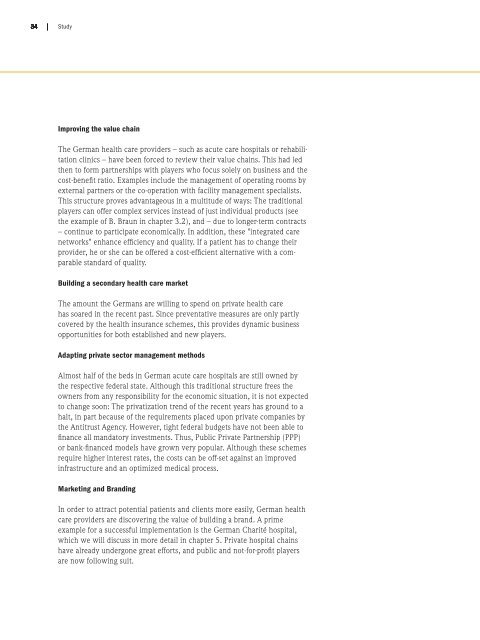Trends in European health care - Roland Berger
Trends in European health care - Roland Berger
Trends in European health care - Roland Berger
You also want an ePaper? Increase the reach of your titles
YUMPU automatically turns print PDFs into web optimized ePapers that Google loves.
34 |<br />
Study<br />
Improv<strong>in</strong>g the value cha<strong>in</strong><br />
The German <strong>health</strong> <strong>care</strong> providers – such as acute <strong>care</strong> hospitals or rehabilitation<br />
cl<strong>in</strong>ics – have been forced to review their value cha<strong>in</strong>s. This had led<br />
then to form partnerships with players who focus solely on bus<strong>in</strong>ess and the<br />
cost-benefit ratio. Examples <strong>in</strong>clude the management of operat<strong>in</strong>g rooms by<br />
external partners or the co-operation with facility management specialists.<br />
This structure proves advantageous <strong>in</strong> a multitude of ways: The traditional<br />
players can offer complex services <strong>in</strong>stead of just <strong>in</strong>dividual products (see<br />
the example of B. Braun <strong>in</strong> chapter 3.2), and – due to longer-term contracts<br />
– cont<strong>in</strong>ue to participate economically. In addition, these "<strong>in</strong>tegrated <strong>care</strong><br />
networks" enhance efficiency and quality. If a patient has to change their<br />
provider, he or she can be offered a cost-efficient alternative with a comparable<br />
standard of quality.<br />
Build<strong>in</strong>g a secondary <strong>health</strong> <strong>care</strong> market<br />
The amount the Germans are will<strong>in</strong>g to spend on private <strong>health</strong> <strong>care</strong><br />
has soared <strong>in</strong> the recent past. S<strong>in</strong>ce preventative measures are only partly<br />
covered by the <strong>health</strong> <strong>in</strong>surance schemes, this provides dynamic bus<strong>in</strong>ess<br />
opportunities for both established and new players.<br />
Adapt<strong>in</strong>g private sector management methods<br />
Almost half of the beds <strong>in</strong> German acute <strong>care</strong> hospitals are still owned by<br />
the respective federal state. Although this traditional structure frees the<br />
owners from any responsibility for the economic situation, it is not expected<br />
to change soon: The privatization trend of the recent years has ground to a<br />
halt, <strong>in</strong> part because of the requirements placed upon private companies by<br />
the Antitrust Agency. However, tight federal budgets have not been able to<br />
f<strong>in</strong>ance all mandatory <strong>in</strong>vestments. Thus, Public Private Partnership (PPP)<br />
or bank-f<strong>in</strong>anced models have grown very popular. Although these schemes<br />
require higher <strong>in</strong>terest rates, the costs can be off-set aga<strong>in</strong>st an improved<br />
<strong>in</strong>frastructure and an optimized medical process.<br />
Market<strong>in</strong>g and Brand<strong>in</strong>g<br />
In order to attract potential patients and clients more easily, German <strong>health</strong><br />
<strong>care</strong> providers are discover<strong>in</strong>g the value of build<strong>in</strong>g a brand. A prime<br />
example for a successful implementation is the German Charité hospital,<br />
which we will discuss <strong>in</strong> more detail <strong>in</strong> chapter 5. Private hospital cha<strong>in</strong>s<br />
have already undergone great efforts, and public and not-for-profit players<br />
are now follow<strong>in</strong>g suit.

















